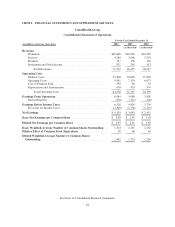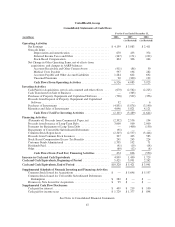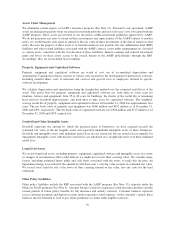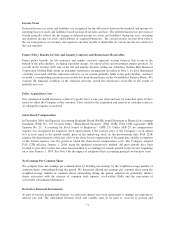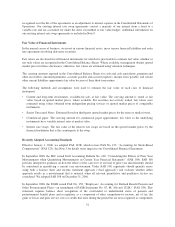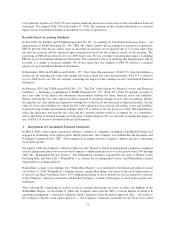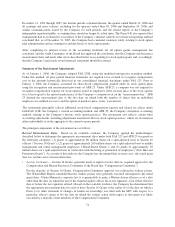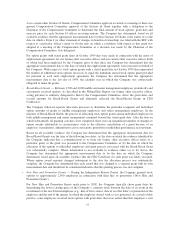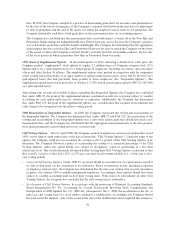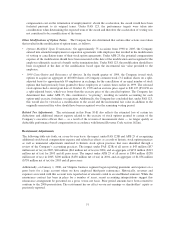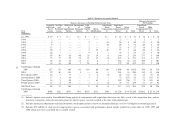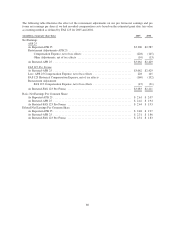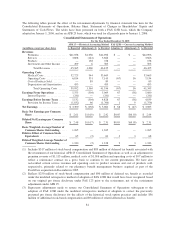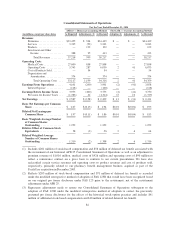United Healthcare 2006 Annual Report Download - page 74
Download and view the complete annual report
Please find page 74 of the 2006 United Healthcare annual report below. You can navigate through the pages in the report by either clicking on the pages listed below, or by using the keyword search tool below to find specific information within the annual report.recognized over the life of the agreements as an adjustment to interest expense in the Consolidated Statements of
Operations. Our existing interest rate swap agreements convert a majority of our interest from a fixed to a
variable rate and are accounted for under the short cut method as fair value hedges. Additional information on
our existing interest rate swap agreements is included in Note 9.
Fair Value of Financial Instruments
In the normal course of business, we invest in various financial assets, incur various financial liabilities and enter
into agreements involving derivative securities.
Fair values are disclosed for all financial instruments for which it is practicable to estimate fair value, whether or
not such values are recognized in the Consolidated Balance Sheets. Where available, management obtains quoted
market prices for these disclosures; otherwise, fair values are estimated using valuation techniques.
The carrying amounts reported in the Consolidated Balance Sheets for cash and cash equivalents, premium and
other receivables, unearned premiums, accounts payable and accrued expenses, income taxes payable, and certain
other current liabilities approximate fair value because of their short-term nature.
The following methods and assumptions were used to estimate the fair value of each class of financial
instrument:
• Current and long-term investments, available-for-sale, at fair value: The carrying amount is stated at fair
value, based on quoted market prices, where available. For securities not actively traded, fair values were
estimated using values obtained from independent pricing services or quoted market prices of comparable
instruments.
• Senior Unsecured Notes: Estimated based on third-party quoted market prices for the same or similar issues.
• Commercial paper: The carrying amount for commercial paper approximates fair value as the underlying
instruments have variable interest rates at market value.
• Interest rate swaps: The fair value of the interest rate swaps are based on the quoted market prices by the
financial institution that is the counterparty to the swap.
Recently Adopted Accounting Standards
Effective January 1, 2006, we adopted FAS 123R, which revises FAS No. 123, “Accounting for Stock-Based
Compensation” (FAS 123). See Note 3 for details on its impact to our Consolidated Financial Statements.
In September 2006, the SEC issued Staff Accounting Bulletin No. 108, “Considering the Effects of Prior Year
Misstatements when Quantifying Misstatements in Current Year Financial Statements” (SAB 108). SAB 108
provides interpretive guidance on how the effects of the carryover or reversal of prior year misstatements should
be considered in quantifying a current year misstatement. Under SAB 108, registrants should quantify errors
using both a balance sheet and income statement approach (“dual approach”) and evaluate whether either
approach results in a misstatement that is material when all relevant quantitative and qualitative factors are
considered. We adopted SAB 108 on December 31, 2006.
In September 2006, the FASB issued FAS No. 158, “Employers’ Accounting for Defined Benefit Pension and
Other Postretirement Plans—an amendment of FASB Statements No. 87, 88, 106 and 132(R)” (FAS 158). This
statement requires balance sheet recognition of the overfunded or underfunded status of pension and
postretirement benefit plans and recognition, as a component of other comprehensive income, net of tax, the
gains or losses and prior service costs or credits that arise during the period but are not recognized as components
72




